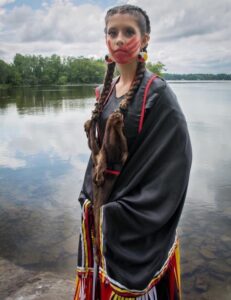‘Why We Dance’ Series: Isabelle Bailey
In an effort to lift everyone’s spirit during this time where we are all staying home, the Anishinabek News did a call out on social media for dancers to submit their stories. The summer series is called: Why We Dance.
Everyone dances for a different reason. Some are just learning. Some feel that it’s a connection to their home and culture. Others dance for healing or to celebrate a personal triumph. And some are competitive dancers. Whatever the reason, our hearts lift up as we see them enter through the Eastern Doorway and join the circle. Pow-Wow dances are expressions of self and spirituality, history and culture. There are many different types of dances and many different styles of regalia to go with the dances. Dances tell important stories – both personal and cultural.
The Anishinabek News hopes this series brings you light and hope during these times of uncertainty, and inspiration to keep moving forward on your journey – whatever it may be; or maybe even dance.

By Isabelle Bailey, Algonquins of Pikwàkanagàn First Nation
When I was younger, I didn’t know about my Indigenous culture. My great grandmother Bernadette was forced to attend a residential school and because of this, our family’s Indigenous heritage was lost. My great grandmother was not allowed to speak her language or celebrate her culture in any way under threat of punishment. Neither my grandfather nor my father were raised in their culture in Pikwàkanagàn, Golden Lake. I always wanted to learn about my Indigenous background, so I began by dancing at the traditional Pow Wow. At the time, I had no idea where these first steps in the Sacred Circle would take me, but I’m so happy that my ancestor’s guided me on that journey.
That journey was not an easy one. I had no teachings to guide me, no Fancy Shawl dance experience, and no one to show me what traditional regalia looked like. I felt very alone going to my first Pow Wow. My family was there, but I didn’t know any of the other children. I felt awkward and out of place. I was alone in the Sacred Circle. When the drums started and I heard the voices of my people raised together in a song sung in an ancient language, my ancestor’s language to the heartbeat of the drums, I felt like flying. I think it’s possible that the muscle memory for dancing is in my genes, or that someone or something guided me through those first dances. It awoke in me a need to connect and bring back knowledge lost long ago for my family and for the generations to come.
Over the years, my dancing improved, I’ve designed and made my own regalia with help from my mother and grandmother. I’ve made many friends who I’ve danced with over the years at Pow Wow. That one weekend of the summer is one of my favourite times of the year. It makes me feel connected to nature and to my ancestors. Dancing feels like honouring my family and saying thank you for all my blessings.
In August of 2019, I designed a new regalia, one with the teachings of the medicine wheel. My regalia was made to represent the four colours/directions/medicines/seasons/ages, etc., that the wheel represents. I painted a red hand on my face to represent all of the voices of the Missing and Murdered Indigenous Women and Girls whose voices have been silenced. I danced for them, I danced in celebration of their lives, I wished for their spirits to join me in the circle and be happy and free. I was taught that the colour red is known to be the only colour that the spirits can see. I wished for them the same sense of joy and healing I feel when I’m dancing in the Sacred Circle.
I truly love to dance. It lifts my spirit and renews my soul. I love that I have found my Indigenous culture.


